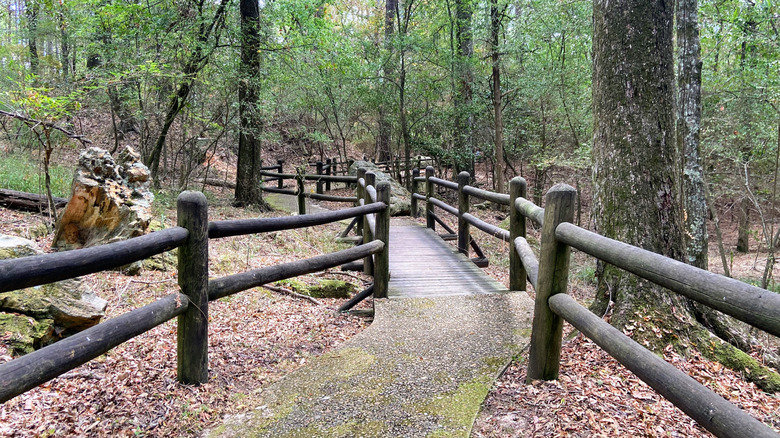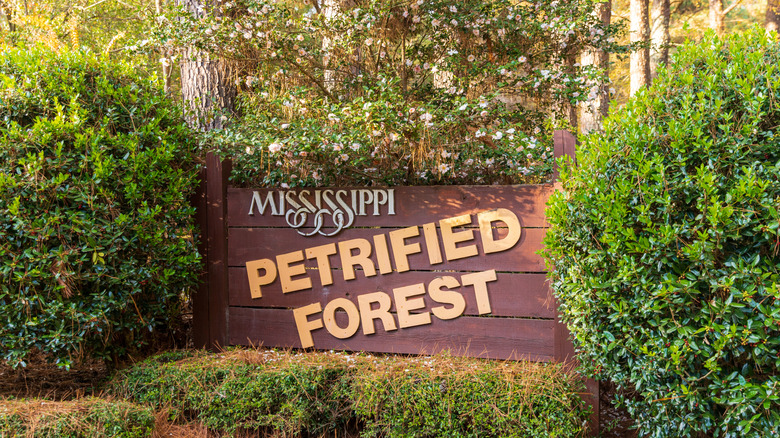One Of Two Petrified Forests In The Eastern US Is A Mississippi Curiosity With A Gorgeous Woodland Trail
Petrified wood is an incredible naturally occurring phenomenon that can be found all over the world, including in the United States. But if you're not familiar with the ancient work of natural art, it can be easily passed over or mistaken for a fallen tree that's been weathered with time. So, what is petrified wood, and why is it so special to find it in Mississippi? Let's find out more about the Mississippi Petrified Forest.
Petrified wood is fossilized wood. Millions of years ago, trees were swept into a river and covered so deeply that oxygen was cut off to the trees, significantly slowing the process of decay. While buried beneath river debris, minerals began to seep into the wood, taking form and solidifying. By the time the wood finally decayed, a crystallized version of the tree remained.
In the United States, many travelers think of or expect to see petrified wood in the western part of the country. It's commonly found in Utah and Wyoming, and the Petrified Forest National Park in Arizona is one of the state's most stunning, lesser-known gems. Because petrified wood is so often found in the West, it's quite surprising to many people that the Eastern U.S. is home to just two petrified forests in New York and Mississippi, making the Southern gem a surprising find.
Mississippi's petrified forest is 36 million years old
The Mississippi Petrified Forest is thought to have been formed some 36 million years ago, making it younger than those of the western states. Here, fir and maple trees were washed downstream to where they are currently located as fossilized versions of the ancient trees. In 1966, the southern state's crystallized forest was named a National Natural Landmark, making it a must-see stop for geology buffs and historians alike.
Walk along the short nature trail to witness these spectacular fossilized trees yourself. There's even a giant log called the "Caveman's Bench" that people sit on to document their visit. After wandering through the natural area, don't skip the museum. Beyond petrified trees, the exhibit holds fossilized leaves, fruits, cones, and bark, making it an interesting collection to view. You can also compare and contrast the differences in petrified plant matter with objects from every state in the U.S., as well as from other countries around the world.
To access the trail and visit the museum, a small admission fee is required. Adult entrances are priced at $7, while student and senior tickets are $6, at the time of this writing. After walking the trail and seeing some wonderful examples of this natural wonder, stop by the gift shop. Here, if you are really drawn to the beautiful natural creations, you can even buy pieces of petrified wood, ranging from small pieces to those large enough to use as bookends.
How to get to Mississippi's petrified forest and where to stay
Roughly 25 miles from downtown Jackson, the nearest major international airport is Jackson-Medgar Wiley Evers International Airport. From here, expect about a 30- to 45-minute drive to the Mississippi Petrified Forest. Because public transportation outside of the city is quite limited and the distance is rather far, it is best to rent a car at the airport. This will allow you to drive to the forest as well as into Jackson, where you will find ample accommodation options.
Depending on your preferred style, choose from hotels, Airbnb rentals, or quaint bed and breakfasts. Those with loyalty membership will appreciate the selection of Hilton hotels, including the Hilton Garden Inn located downtown. Other options include the Westin and the Old Capitol Inn. For a boutique inn experience, try the Orchid Bed and Breakfast or the Fairview Inn.
So, when you plan a trip to Mississippi, don't pass over the petrified forest. While Jackson is the gateway to the aptly named Small Town, Mississippi, home to a unique, immersive exhibit, it's worth road tripping beyond the city to take in natural landscapes. You'll even find a cypress swamp that can rival Illinois' secret, mysterious bayou, deemed "one of nature's masterpieces."


